by Tom Gaylord
Writing as B.B. Pelletier
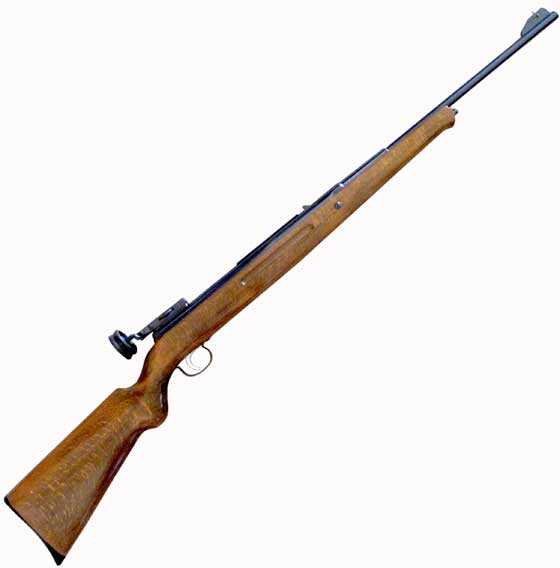
Diana model 50 underlever.
This report covers:
- History
- Findlay
- Fortune smiles!
- Not the first
- Taploader — oh oh!
- Description
- Evaluation so far
Enough about straight razors and coin collections! Let’s get back to vintage airguns. Today we begin a series that looks at the venerable Diana model 50 underlever air rifle.
History
According to the Blue Book of Airguns, Diana’s model 50 was produced from 1952 until 1965, when the T01 variant took over. That one lasted until 1987, so in all the rifle had nearly a 4-decade run.
The model 50 is an underlever spring-piston air rifle that came in both .177 and .22 calibers. I think the .22 isn’t as common, since the 50 was seen as a target gun and Europeans were already using .177 caliber for that. Maybe .22 was a nod toward marketing Americans, with whom the larger caliber was much more popular at the time.
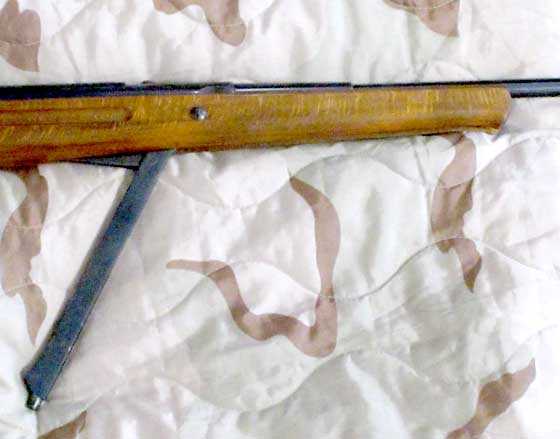
The underlever is short, but the rifle is still easy to cock.
Findlay
I acquired my rifle at this year’s airgun show in Findlay, Ohio. That show is turning out to be one of the best airgun shows I ever attended! I was walking through the show and this rifle sort of jumped out at me from one of the tables near the center of the room. One thing that attracted me was the peep sight it was sporting. It is a type of Diana peep I have never seen, and it looked so good on the rifle. It reminds me of the Diana peep that was made out of a conventional rear sight, only this older one wasn’t made that way. It is a dedicated peep.
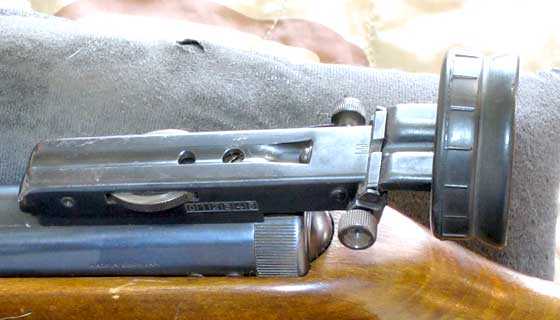
This Diana peep sight is one I haven’t seen before. Naturally it’s fully adjustable.
The other thing that caught my eye was the rifle’s condition. At first glance it appeared to be 99 percent. With longer examination I’ll knock that back to 92 percent, but it’s still a pip! The bluing is 97 percent, but the wood has scratches, dents and finish loss that knocks it back to maybe 88 percent.
Fortune smiles!
Usually I’m the guy who buys the common airgun instead of the super-dooper one that’s a rarer variation. This time was an exception. My rifle is what the Blue Book calls a Variant 3, which means it came with the rear peep and a 4-post front sight that the user adjusts with a dial to suit his taste. It has a thin perlkorn (a tapered post), a fat perlkorn, a squared-off target post and a post and bead. It’s supposed to have a sheet metal hood over the sight, but that was missing on mine. This sight alone is enough to make me want this rifle! The only feature my rifle doesn’t have is a larger target-style stock.
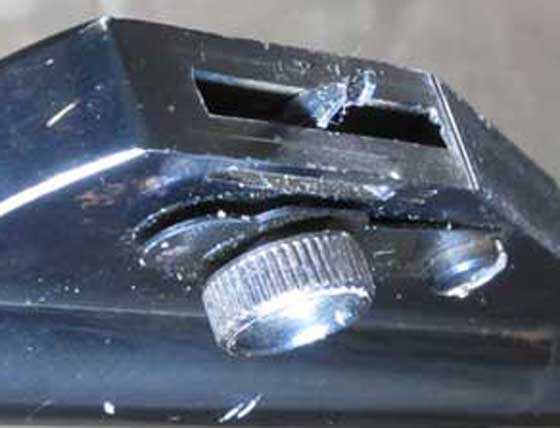
The bead on post. That dial selects which of the 4 posts you want.
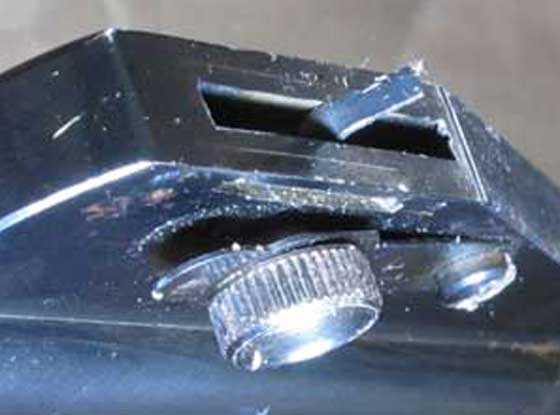
Target post.
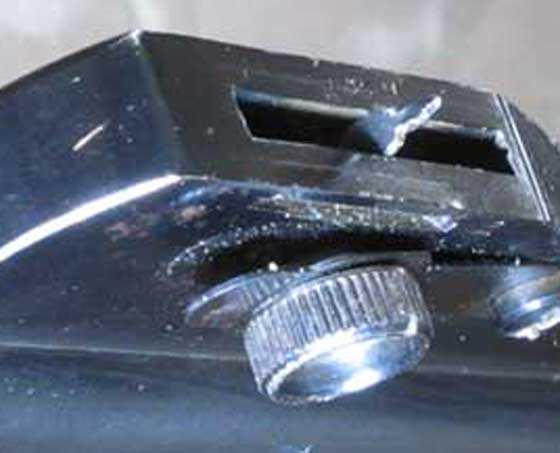
Narrow perlkorn.
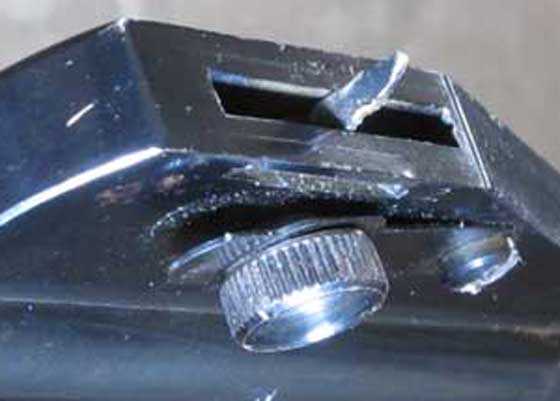
Wide perlkorn.
Not the first
This is not the first Diana model 50 I have owned. Back when I was writing The Airgun Letter in the 1990s I had a Diana 50 that I’m pretty sure must have been the later model with the T01 trigger. The stock was much thicker on that one and I didn’t take to it. It was curious, but felt fat and clubby and was not something that grabbed me. This earlier model 50 is different. It’s slimmer and just looks and feels right to me!
The rifle comes with an adjustable trigger, and for once I don’t have to do much with it, if anything. It releases with very light pressure that I will measure for you in part 2. My guess is it releases at less than a pound. Since the T01 trigger didn’t come about until 1965/66, I assume this one is Diana’s ball-bearing trigger — a proven design that I love!
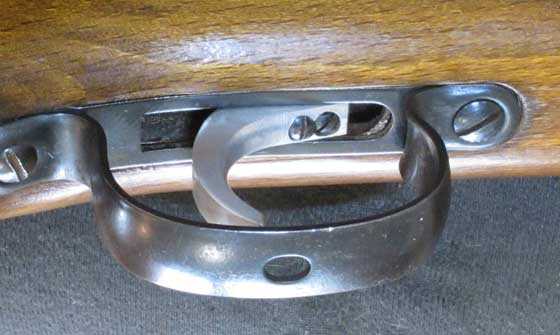
I’m pretty sure this is Diana’s ball-bearing trigger!
There is no automatic safety. In fact, there is no safety at all! The loading tap keeps fingers safe during loading and I guess the rest will have to be left to the shooter.
Taploader — oh oh!
This rifle is an underlever that uses a loading tap to load the pellet. The tap is manual, so after you cock the rifle you must open it and drop in a pellet, nose-first. I never tried opening the tap until several weeks after returning home from Findlay. When I did try it for the first time I discovered it was very hard to move. So hard, in fact, that I thought the handle might break off.
I fixed that while writing this report with Kroil, a penetrating oil. First I filled the tap while it was closed, then I opened and closed it several times to distribute the oil. That helped a little. What really helped was when I did it a second time and tipped the rifle slightly to the right while opening and closing, to let the Kroil flow to the right side of the tap mechanism.
On the Diana 50 — at least on this older one — the loading tap does not go all the way through the spring tube. There is nothing visible on the right side of the spring tube. This is the first tap I have seen that didn’t pass all the way through the tube. I am thinking that Kroil might have been the first oil to get to that side of the tap since the rifle was new, 60+ years ago.
The tap now moves much easier, though it is by no means loose. It still has resistance to turning, but that comes from the precision fit, not from sticky lubricants!
Description
The test rifle is 45 inches overall. The barrel is approximately 19.5 inches. The rifle weighs 8 lbs. 1 oz. on my balance beam scale. The stock is full-sized with a 13.5-inch pull.
The stock is beech wood with a medium brown finish and no checkering. Finger grooves run down both sides of the forearm, in classic European styling. The butt plate is hard black plastic with the Diana name inside a circle. It provides no slip resistance.
All the metal is well polished and deeply blued with black oxide. Even both sights are steel that has been blued. The only non-steel part that I can see is the aluminum trigger blade.
Evaluation so far
I’m excited about this rifle. It’s well made and has several upgraded features — especially those target sights. I can’t wait to try out that front sight. All things considered, I would say this is a classic!
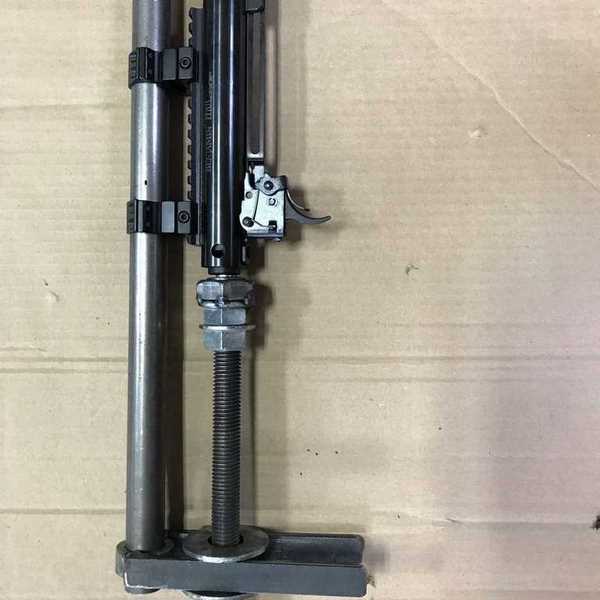
B.B.
What a lovely find! When did Diana change from Original? How is this trigger different from the T01? I though the T01 used ball bearings?
Thanks,
Yogi
Yogi,
Diana was never fully Original. They had to use that name when the Brits got their factory as WW II reparations. They were always Diana, but in some markets (the UK and America/Canada) the Milbro company was using the Diana name for several years, so Diana called themselves Original just for those markets.
B.B.
Yogi,
I didn’t answer the part about the ball bearings. The T01 is a unitized trigger — the first Diana made. The ball bearing trigger is not unitized. It comes out of the gun as a mess of separate parts.
B.B.
hi b.b,
i saw your article thanks to a link on the u.k vintage diana forum,
i have a nice Gecado marked model ‘e’. i believe that it is 62-63 vintage.
almost the same except mine has a basic[similar to a mk1 meteor etc] Diana sight 1/2 way between the tap and end cap.it also has threaded holes for the diopter,
all the best.martin.
London U.K
rynner,
Welcome to the blog.
You have an interesting rifle. Did you see my report on the Meteor Mark I?
/blog/2016/11/bsa-meteor-mark-i-part-7/
B.B.
Kano Kroil and Kano Silikroil and Kano Penephite belong in all MENS garages. Millennials probably won’t get it
Kevin,
We used the heck out of Kroil at the factory where I used to work. It’s great stuff and I really like the smell, but I’ve never heard of the other two products you listed. Are they safe for air guns? For that matter, is straight Kroil safe for all parts of all guns, if you know?
Halfstep,
I was introduced to Kano Kroil many decades ago when I participated in 3 position smallbore competitions. Everyone used Kano Kroil inside their barrels. Back then it was very common to cork the barrel, fill it with Kano Kroil, let it sit overnight then clean the barrel.
The only time I’ve used Kroil on airguns is when screws wouldn’t budge. Usually small screws on vintage peep sights since they’re notorious for becoming welded.
If I was B.B. I would have used either Kano Silikroil or Kano Penephite on that tap since these products not only contain Kroil but either silicone or graphite as a long term lubricant.
http://www.kanolabs.com/
Kevin,
I was introduced to it and a product called 711(also a penetrating oil,though not nearly as good) about 44 years ago as an apprentice. Do any of your shooting buddies pronounce it Kro Ohul? Nearly all the old timers did where I worked, and as a result, all of their apprentices, me included, learned to say it that way. Like it’s two words and the “oil” part is just kind of slurred.
I am sure that this Diana ( model 50 ) feels and balances more like a Mauser 98 than the new Diana Mauser 98. I hope that you will compare these 2 rifles. ——Ed
Ed,
I hadn’t thought to do that, but for you I will make the comparison. The Diana 98K has a fatter stock. It feels more like the other Diana 50 I used to have. Both rifles are muzzle heavy, though the 98K is a little heavier.
I like this model 50 better because of the feel when held, but it probably isn’t half as powerful as the K98. As for accuracy, we’ll see.
B.B.
Very nice. The wood looks to have some flame. Love the Schnabel. The sights are awesome, and a tap loader to boot. I can see where this one would have been hard to pass over.
Chris,
Yep, this one’s going to my estate sale. Unless it isn’t accurate.
B.B.
Estate sale? No, no, no! 🙁
Any danger of the Kroil getting where it might cause dieseling?
HS,
Sure there is a danger. But I will wait several days before shooting
B.B.
It looks like there is a full blog on the sights alone. I’m curious about the numbers on the left hand side of the rear sight, as well as the hole in front of the mounting screw. What do you think about the eye shades,I see European shooters using them but not a lot here.
BB—-Thank you for planing to compare this Diana to the current Diana 98k. Power is not important to me. I only shoot air guns at 10 meters and at targets. When I go hunting, I start with my .17 HRM, and use more powerful rifles when needed. If the Diana 50 passes the accuracy test, I will try and get one to replace my current Diana 98K.—-Ed
BB—I looked up—vintage Diana air rifle sights—–and the sight on your Diana 50 was there. —–Ed
BB,
in your next installment, could you include a photo of the tap loader mechanism? Thanks.
Fred formerly of the DPRoNJ
Fred,
Would you believe I did take that picture, then promptly trashed it before putting it into the blog. I intend to take one in Part 2.
B.B.
BB,
That front sight is genius. I have two guns that I got long ago that have replaceable front blades and I carefully stored the blades that I wasn’t using at the time, only to completely forget, over time, where that was! Can’t do that with this setup. ( Do you know where I put those spare blades, by any chance?)
Halfstep,
Yes, I do! I will tell you when you tell me where three of my sox vanished to from my dryer.
B.B.
BB’
I’m certain that my wife would insist that all three of your socks are in my garage, basement, office, or any of the five or six other places where I employ my personal cataloging system. ( Did your Edith have as much trouble understanding such systems as my wife does? )
BTW, did your area have much of an eclipse? We had about 90% here in KY.
Halfstep,
Edith was fond of saying that a messy desk was a sign of intelligence and that I must be a genius!
We had 74 percent here. I was able to see it clearly with a pinhole camera (two sheets of cardboard with a hole in one”, and by making a circle with my thumb and forefinger and allowing the light to shine on the sidewalk.
B.B.
BB,
To cock this gun do you have to pry on that little rounded end of the lever to free it for grasping? How tightly is it held and what is the nature of it’s holding clamp,clip or whatever?
Halfstep,
You push in on the large button on the end of the lever to release it for cocking.
B.B.
BB
The 50 lasted until the early 80s.
The 50TO1 (a 50/45 hybrid) came along in 1981.
Geezer,
I was going by what is in the Blue Book. It says the earlier design lasted until 1965 and then it says the T01 went from 1952 to 1987. Well, that is obviously wrong, so I started the T01 when the earlier model retired — according to the Blue Book.
If you have different information, where did you get it?
B.B.
Personal memory, checked with the second edition of John Walter”s Airgun Book (which says 1981 for the TO1) and Dennis Hiller’s Collector’s Guide to Air Rifles (which suggests late 70s, but Hiller is less reliable on precise dates). I also own a mid/late 70s model 50, which is definitely not a TO1, but is a cheapened version of the rifle you have. Mirroring the way the 35 evolved.
Very nice 50, by the way.
Incidentally, I think you may find that the aperture can be removed to reveal a notch open rear – the body of the sight certainly looks like the standard Diana 1950s sight that could, with the right factory add-ons, do double duty as an aperture sight.
Geezer,
Thanks. I will look into it. Robert Beerman edited the Blue Book, and he had direct access to many companies, but that doesn’t mean everything is right.
As for the aperture, if it comes off there is no rear notch. What looks like one in the picture is three times too wide to work. Maybe there was a notch that could be attached, but the way it is now there’s nothing.
B.B.
Yeah im pretty sure Geezer is correct. Its also my understanding they didn’t make the t01 variant for very long. Ive only ever seen one for sale here in Australia, so i bought it! Not a bad rifle, high velocity (.177 800fps ish, from memory mines ’85 or ’86)) and decent accuracy, however its not without its drawbacks. Recoil is excessive, and without (i assume) one of the special scope bases that locks in the rail its impossible to keep a scope from walking of the rail. Incidentally,when i got this rifle the rail was fogged out, all bolts(not riveted on like my 27’s and 35’s) stripped out and i had to re-tap the lot.It gets very heavy shooting of hand, i compared its weigh to my scoped Brno model 1 and even without optics, the 50 is heavier! I even wonder if she weighs as much as a 303! It also gets rather tiresome cocking after the first dozen shots! The stupid auto safety can go and jump as well, cant stand it! The original models shoot nicer, cock with less effort and %100 have better build quality. From working on my collection, which goes from 30’s to mid 80’s, the build quality seemed to go down hill from the 70’s, at least though the 70’s models (here at least) got rid of the plastic rear sight from the more sturdy metal one.
At the end of the day i like having the 50t01, but i much prefer shooting my 27’s 😉
i can see the cocking lever just peeking out of the stock, but I would think that shortening it like that increases the loading effort.
I had another day at the shooting range over the weekend where things are never dull. This time I saw two high-quality airguns at the 50 yard line. One had a large bulbous reservoir which I did not recognize. But the other, I’m pretty sure, was the Benjamin Marauder, making this my first sight of the actual gun. It looked pretty cool. But I saw the owner later working away at the hand pump in the extreme heat, and that removed a bit of the luster. The heat taught me about some gear of my own. I wore my jack boots and found that they performed marvelously well outdoors, really on anything but a highly polished surface. But the sole made of iron, leather, and what looks like wood, does not give at all, and I developed a blister. Marching 30 miles a day in these boots as was done is beyond believing. I’m trying to use the boots to contact the past, sort of like the way a psychic does with physical objects, although I’m not trying to reach any one person but an historic sensibility. I sense…a tremendously authoritarian culture going back to Roman times whose footgear was hard on the ground and the people wearing it too. It’s like a line in the Forgotten Soldier where the author says that the German army treated its own soldiers as badly as prisoners. On top of that, the boots, with the thick socks necessary to fit them, were extremely hot.
After a time, I was wondering why I felt like I was about to drop over, and then I thought of my world class hearing protection which is deformable ear plugs inside of earmuffs packed with cotton. This set up reduces 30 caliber rifles to a mere pop, and .22LR sounds like less than an airgun, but now I know why earmuffs are so useful for keeping you warm in winter. They prevent the ears from radiating heat. Now all those layers that I used to block sound were also blocking the transfer of heat. Between that and the boots I was near collapse.
Anyway, the order of the day was to continue using a firm sandbag under the back rest to see if I could improve my performance with my rifle collection. I was shooting the Mosin sniper rifle and my Anschutz target rifle. I’ve developed more respect for bench resting which takes more skill than I thought. Even with my sandbag in place and adjusted to the correct height, there was significant play in the muzzle, enough to sweep out a pretty unimpressive group. I shot four groups of five shots with the Anschutz. Three were unimpressive, hovering at a little over 1 MOA at 100 yards. But the last one was a measured .3! Maybe everyone gets one of these in their life, and this was mine. The statistical distribution would seem to indicate that this was luck. But perhaps there is another factor. If you can call a shot bad, can’t you call it good? On that last group, I had my sandbag positioned correctly. My technique was good. And the Jaws of the Subconscious were chomping away. If I perceived all these things while shooting and the results were good, doesn’t that argue against the group being random? Admittedly, this removes a bit of objectivity from the process, but there still seems to be some cause and effect.
Then, it was time for the Mosin. I only had time for one group of five which I fired off, but when I looked in the scope, it was about 3 inches. Boo. That would have gotten me kicked out of the Russian sniper school where Major Lyudmila Pavlichenko shined so brightly. Oh well, I’ve given up on trying to benchrest the old military rifles and use them more for offhand which they were mostly designed for. Here the rifle did better and allowed me to actually group at 100 yards. The group was the right half of the paper, but that’s still a group. For all of its quirks, my cagey old Russian rifle with the scope is my most accurate 30 caliber rifle. You might say that the Mauser, Enfield, and accurized Garand might do better if they had scopes. But the Russian rifle already has the scope which was part of its achievement in wartime.
geo791, you must have the deluxe model of the Fusion ProGlide. I don’t see any place for batteries, but mine works fine without them.
Matt61
Yeah, mine is a Power Fusion Proglide. It’s exactly the same but with one AAA battery to vibrate the blades. They do differentiate which blades are power and which are not though. I don’t know what the difference might be.
Showing off my home made rail mount spring compressor.
Coduece,
Aren’t you a clever guy!
B.B.
BB
My ignorance is about to go on display.
Do pneumatics need decompressing before disassembly. If they contain compressed air the answer has to be yes! Question is how to do it.
Decksniper
Decksniper,
YES, YES, YES a pcp must be degassed before disassembly.
Some can be degassed with normal tools, some need a special degassing tool, some must be shot out of air with pellets to insure you don’t shoot out o rings while others can be shot out of air without pellets. You will usually hear a hiss of air when the valve allows the last bit of air to “exhale” from the pcp.
What pcp are you talking about?
Kevin
Three types of pneumatics; single pumps, multi pumps and PCP’s. What raised the subject for me is my Webley Rebel multi pump. I’m wondering if a valve is locked. The pumping lever pivot pin is bent enough to change the piston’s length of travel. I left it alone for a couple of months thinking a faulty valve may leak any compressed air out. I got it out a coule of days ago and I’m guessing it had. I shot 20-30 pellets with reasonable accuracy before it locked up again. The pump does not move any air and no air is released when shooting. I removed the pellet from the chamber for future safety. The pivot pin looks easy enough to remove but no way I’m going to if there is compressed air inside. The Webley Rebel is an inexpensive but fun rifle. Not worth the expense to send off for repair.
Decksniper
BB
I should have added how does one know for certain the gun has been shot out of air?
Decksniper
Decksniper,
When you cock it and pull the trigger and only hear a click. However, that can also mean a locked valve from overpressurization, so before the valve comes out of the gun, make sure the valve stem is free and can be depressed. If it can, you have done all that can be done.
B.B.
Sure it’s a little cluncky and chunky but so far so good.
Coduece,
Very nice. I like the up and down height adjustment feature. Does the head that contacts the end cap free float so that it does not spin as you are turning? I like it. 🙂
Thanks for commenting I was shooting my 392 and I needed a break.
Yes I used a roller bearing set into a nut with a removable brass stud to fit in the hole in the end cap. It works very well so far.
Coduece,
Well, I would say that you “one-upped” the commercial unit. Is the top tube pipe/conduit of sorts,.. or solid rod? I do not know the maximum amount that would be needed to decompress/compress the longest spring,… but I assume that you have plenty of travel built in? I think that many cheap, high powered springers are way over sprung. GF1 proved that, even on quality springers.
I have some 3/4″ acme rod and a nut stashed if I ever choose to make one. The TPI is much less and turn travel would very quick. Maybe someday.
Very nice and congratulations for pulling it off.
Thanks your opinion means a lot, everyone on here has been so helpful, and I’m very grateful, the more I learn the more I want to learn more!
And the shaft going through the scope mounts is solid. It’s a little heavy but it’s what I had, as far as travel my all thread is 12 inches long, I wasn’t sure how much I would need so I over killed it just a bit.
Coduece,
Yup,..12″ ought to get the job done! 😉 Keep us posted on future employment(s) and type of guns that you use it on.
On the subject of “over building”,… years ago I made a real tree Christmas tree stand that probably went a good 20#. Lock down the four 1/2″ all thread T handles and an 8 foot tree is not going anywhere. 🙂 I have always been inclined to over build,… with no regrets.
Coduece
Definitely like the slide adjustment. Plus all the forward backward adjustment of the rod in the scope rings.
That spring compressor you made should be marketed. And I’m serious. For real. I like it. 🙂
And I’m surprised RidgeRunner hasn’t said anything about this model 50.
It reminds me alot of the Diana 46e I had that RidgeRunner now has.
B.B.,
I confess to being very excited about this report and its future installments!
It took me a long time to find the “right” Model 50 for me, here in the United States. They seem very common in the UK, but they are seldom seen here on this side of the Atlantic. Mine, like many U.S. 50s, is branded a Winchester 450 imported by Daisy. Mine is West Germany made, not Milbro, although I have read that the Milbro ones are well done. Personally, I cannot comment on that.
One of the very important lessons for folks to know is that the three-ball-bearing sear models with the locking screw next to the trigger adjustment screw are the desirable ones. They are low-powered, smooth-shooting, and for having such short cocking lever, easy cocking. For their low power, they are also long and heavy. Perhaps that is why they never caught on in the United States. The later, higher powered ones are considered a different and lesser model, as I understand it, anyway.
Mine lacks the aperture rear sight and forearm Schnabel of yours, and its front sight is a perlcorn but is hooded and has a more slender base than yours. Mine might be non-original.
You have one gorgeous air rifle there, and I will read every report you write on it with great interest.
Michael
B.B.,
I just took a peek at my 50, and it does have a Schnabel.
Michael
Hi BB,
What a beauty! One of my favorite classic air rifles, looking forward to the details.
More on that unique rear sight: it is intended to work in two completely different modes.
You can remove the peep attachment, and the open sight should have a rotating plate with 4 different notches in it; each notch corresponds to one of the front post shapes (it may be missing on your sight). The plate is loosened for rotating by the little screw mounted at an angle just in front of the plate. In this mode the sight can be removed, and mounted on the rail on the front of the receiver tube.
To use the sight as a peep, rotate the plate to the wide round notch (necessary to clear the view in front of the aperture hole), and mount on the short rear rail, as you have it now. A complex but marvelously versatile design!
The model 50 was sold in most markets in 4 variations in those days:
50E, plain sporting model with simple fixed post front and leaf-type rear sight.
50/A, target model with standard stock and the sight like yours, but without the peep attachment.
50/B, same as 50/A with the peep attachment added.
50M, 50/B action and sights in a heavy match stock with deep fore end and cheekpiece.
In the early 60’s, these early models were all replaced by a single simplified version–still a very nice rifle, but the gorgeous forged cocking arm, multi-mode sights, solid metal trigger, etc., were gone.
Mike D
Mike,
Thanks for that. I can’t see how this peep can be used as an open sight. Is mine missing something?
B.B.
Here is a post on the Vintage Diana forum gallery, showing the model 50/A, 50/B, and 50M variations together. The two-function sight can be seen in both modes:
http://www.network54.com/Forum/662823/message/1273575685/Three+Diana+50+variations+together
Your gun is a beautiful example of the model 50/B.
Hi Tom,
I actually have 5 of these sights. While there are some minor differences, each one has a rotating plate at the rear with 4 different sight notches.
That being said…you should be able to see the top edge of this plate when looking at the top of the sight. And I don’t see it, in your excellent photo of your sight! So you may have a variation I’m not familiar with.
If I’ve done this right (still struggling with Imgur after the Photobucket debacle), below is a photo of one of my sights. It’s upside down, with the aperture disk and eye shade detached:
[img]http://i.imgur.com/IyaZke7.jpg[/img]
And here is a shot of a parts diagram, from Dennis Hiller’s “The Collector’s Guide to Air Rfiles.” The notch plate is part no. 17:
[img]http://i.imgur.com/YB83NaH.jpg[/img]
[img]http://i.imgur.com/IyaZke7.jpg[/img]
AND I obviously picked the wrong share links. One more try:
http://imgur.com/IyaZke7
http://imgur.com/YB83NaH
Mike,
Once again you have come to the rescue! I removed the peep disc and found the rear sight plate you described. I’ll show it in the next installment.
Thank you so much.
B.B.
BB, glad to be of help! This complex sight is one of my favorite designs…hard to imagine such a thing coming on an air rifle today.
Another detail I forgot to mention: the odd row of numbers on the left side of the sight is actually the elevation scale. As you adjust the sight upwards, you will see a stepped line, stamped in the sight base underneath the number. Each step in this line, corresponds to one full turn of the big elevation wheel, so you can tell at a glance how far you’ve move the sight.
Mike,
Thanks. There was a question about those numbers and I knew what they were. I should have shown and explained them in Part 1.
B.B.
I just can’t stop admiring this beauty
Here I found someone selling this at about 100 bucks but I already invested my money and ordered a new beast
This is not just an air rifle it’s a history a piece of delicated art wish touch one someday
Good morning,
I have read your speeches and I need help.
A friend gave me a Diana 50a which, unfortunately, needs to be restored but I can’t find the spare parts.
I am in Sardinia, an island in the middle of the Mediterranean sea and, honestly, I don’t know how this rifle ended up here. Can anyone help me out?
In particular, I need some pieces of the viewfinder and rear sight, corroded by rust.
Thanks.
Zeleddu,
Only a few people will be able to see your post. Please post your request in the latest blog so that more can reply to you. One possible source is: https://www.omps2.it/en/firearm-spare-parts/diana-spare-parts/mod-50.html
another is: https://www.airgunspares.com/store/category/64/791/DIANA-ORIGINAL/
Hope you are able to fix it.
Siraniko